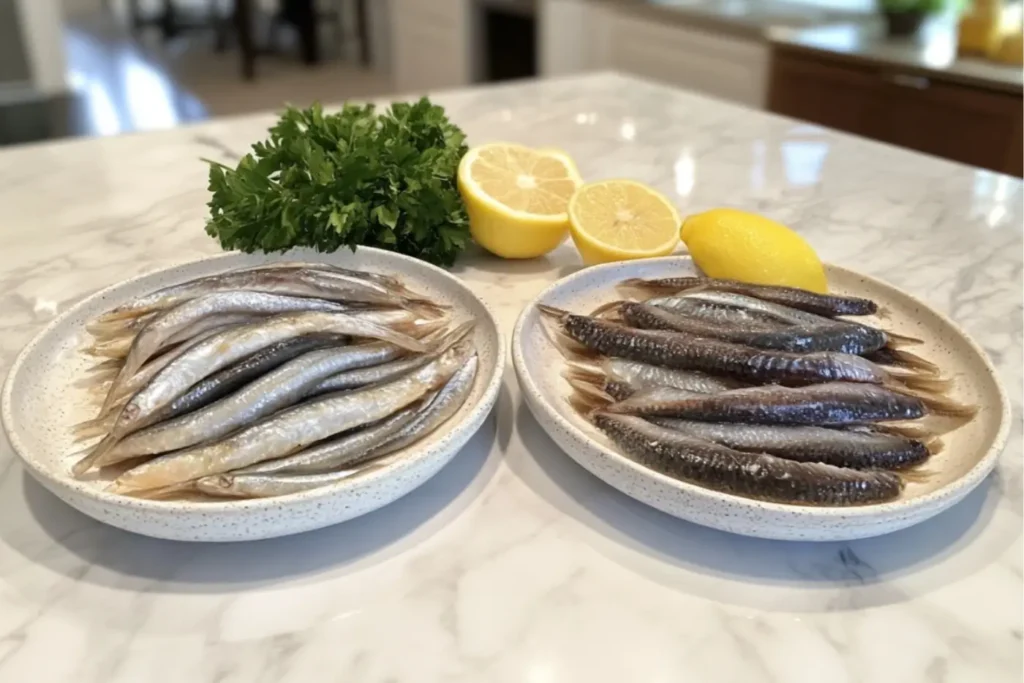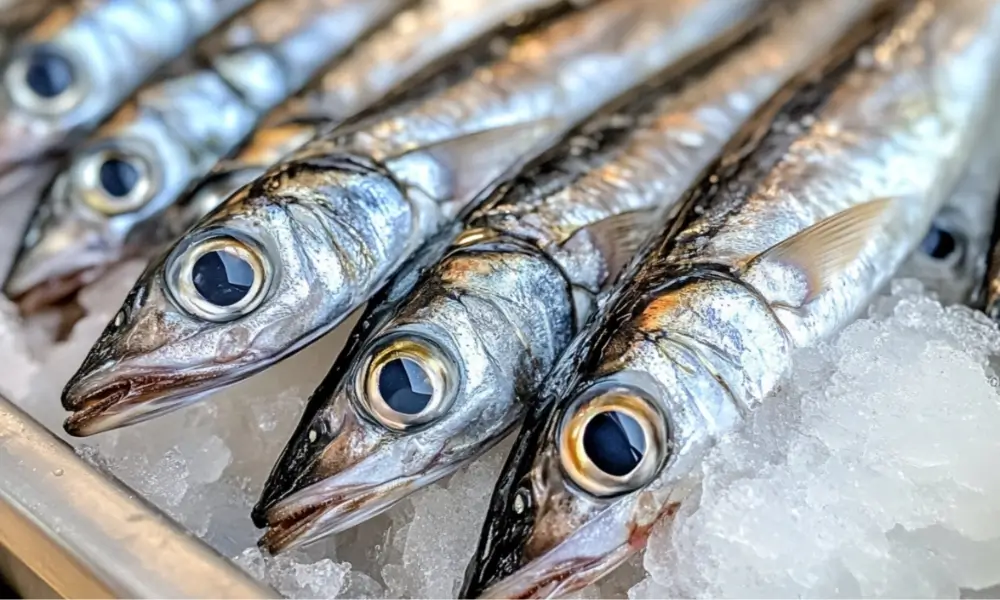Ever wondered, “What type of fish are boquerones?” If you’re a fan of Mediterranean cuisine, chances are you’ve come across these delicious little fish. Boquerones are not just another seafood delicacy; they have a rich history, incredible health benefits, and a unique taste that sets them apart from other fish. Whether you’re a foodie or just curious, this guide will help you discover everything about boquerones, from their origins to how you can enjoy them at home!
Introduction
Defining Boquerone: What Exactly Are They?
Boquerones, often confused with anchovies, are small fish from the Engraulidae family. Commonly found in the Mediterranean and Atlantic, they are a staple in Spanish cuisine. Unlike the salty, cured anchovies most people know, they are typically marinated in vinegar, giving them a tangy, delicate flavor.
These little fish are commonly sold fresh, pickled, or preserved in olive oil. Their delicate, white flesh and slightly sweet taste make them a favorite in tapas bars across Spain, often served with a side of olives and crusty bread.
“Boquerones bring the flavors of the sea straight to your plate, offering a burst of freshness in every bite.” 🌊
The Popularity of Boquerone Across the Globe
Boquerones have gained global popularity, enjoyed for their mild, slightly sweet flavor that pairs beautifully with tapas, salads, and sandwiches. Whether served as boquerones en vinagre (marinated in vinegar) or fried to crispy perfection, they are a favorite among seafood lovers.
In countries like Italy, France, and Greece, they feature in local dishes. Often served as antipasti in Italy or included in Mediterranean mezze platters, they add a touch of authenticity to any meal.
Key Characteristics That Make Boquerone Unique
- Delicate texture: Soft, tender flesh that melts in your mouth.
- Mild yet tangy flavor: A perfect balance of umami and acidity.
- Versatile preparation: Can be marinated, fried, or served fresh.
- Rich in nutrients: A fantastic source of omega-3s and protein.
The Origins and Habitat of Boquerone
Natural Environment and Geographic Distribution
Boquerones primarily thrive in the warm coastal waters of the Mediterranean and Atlantic. They travel in large schools, making them easier to catch in regions such as:
| Region | Significance |
|---|---|
| Spain | Primary source of traditional boquerones dishes |
| Italy | Used in antipasti and pasta dishes |
| Morocco | Exported in preserved forms to European markets |
Boquerones prefer waters that are slightly warm, where they can feed on plankton and small crustaceans. They are often found near coastal regions, which is why countries with extensive shorelines have incorporated them into their culinary traditions.
Fishing Methods and Sustainability Practices
With growing concerns about overfishing, sustainable fishing methods for boquerones are essential. Fishermen use purse seine nets, which help minimize bycatch and protect marine biodiversity. Additionally, efforts are being made to regulate fishing seasons to allow populations to replenish.
Many eco-conscious brands are now offering sustainably sourced boquerones to support responsible fishing practices and protect marine life.
Seasonality: When Are Boquerone Available?
While boquerones are available year-round, they are at their peak from spring to early summer. This is when their flavor and texture are at their best, making it the perfect time to enjoy them fresh. If you’re looking for the freshest catch, visiting a local fish market during these months is your best bet.
How Boquerone Differ from Other Small Fish Varieties

Boquerones vs. Anchovies: A Detailed Comparison
People often confuse boquerones with anchovies, but they’re quite different. Here’s a quick breakdown:
| Feature | Boquerones | Anchovies |
|---|---|---|
| Flavor | Mild, slightly tangy | Salty, intense |
| Preparation | Marinated in vinegar | Salt-cured |
| Color | Pale, white flesh | Dark brown, almost black |
Differences in Flavor Profiles and Textures
If you prefer a milder taste with a hint of acidity, boquerones are the way to go. They’re soft and tender, unlike the chewy and salty texture of anchovies.
Culinary Uses: What Sets Boquerone Apart?
Boquerones are incredibly versatile. You can enjoy them as:
- A topping on crusty bread with olive oil and garlic
- A protein-packed addition to fresh green salads
- A standalone appetizer with olives and pickled vegetables
Nutritional Profile and Health Perks of Boquerones
| Nutrient | Per 100g |
|---|---|
| Calories | 210 kcal |
| Protein | 25g |
| Fat | 10g |
| Omega-3 Fatty Acids | 1.5g |
Essential Nutrients Found in Boquerones
Boquerones are packed with protein, omega-3 fatty acids, and essential vitamins like B12 and D, making them a healthy addition to any diet.
Stay tuned for the next part where we’ll dive into storage tips, cooking techniques, and common challenges faced when handling boquerones!
Common Challenges When Cooking or Eating Boquerones
Managing the Strong Flavor of Boquerones
One of the most common concerns people have when trying boquerones is their distinct flavor. While they are milder than traditional anchovies, their tangy taste can still be overpowering for some. A simple trick? Soak them in milk or water for about 20 minutes before using them in recipes to tone down the intensity.
“A quick milk soak can transform boquerones from bold to beautifully balanced!” 🥛🐟
Addressing Texture Concerns: Soft vs. Firm
Some people find the texture of boquerones a bit too soft, especially when marinated. To add a little bite, try serving them with crunchy elements like toasted bread or crisp vegetables. On the other hand, frying boquerones gives them a delightful crunch that can win over even the pickiest eaters.
Proper Techniques to Debone Boquerones
Dealing with tiny fish bones can be tricky, but there’s an easy way to enjoy boquerones without the hassle. When preparing fresh boquerones, gently split them down the middle and remove the backbone using your fingers or tweezers. Most store-bought versions come pre-cleaned, making them a convenient option for quick meals.
Selecting and Storing Boquerones for Maximum Freshness
Tips for Choosing the Best Quality Boquerones
When shopping for fresh boquerones, look for:
- Bright, clear eyes – Cloudy eyes indicate the fish isn’t fresh.
- Firm flesh – Press the fish gently; it should spring back.
- Minimal odor – Fresh boquerones should have a mild, ocean-like smell.
Refrigeration and Preservation Best Practices
To keep boquerones fresh, store them in an airtight container covered in olive oil or vinegar. Refrigerated boquerones can last up to two weeks if properly stored. For longer storage, freezing is an option, but it may slightly alter the texture.
Shelf Life of Fresh vs. Preserved Boquerones
Preserved boquerones, such as those packed in oil or salt, have a much longer shelf life compared to fresh ones. They can last for several months when kept in a cool, dark place. Once opened, it’s best to consume them within a few days to enjoy their optimal taste and texture.
Culinary Uses of Boquerones in Various Cuisines
Spanish Tapas and Boquerones: A Perfect Match
In Spain, boquerones are a staple in tapas culture. Whether served simply with a drizzle of olive oil or alongside patatas bravas, their versatility shines. They’re commonly paired with a chilled glass of white wine or beer, making them a favorite among locals and tourists alike.
How Other Cultures Incorporate Boquerones
Beyond Spain, boquerones are embraced in various cuisines:
- Italy: Used in pasta dishes and antipasti platters.
- Greece: Often grilled and served with lemon and olive oil.
- France: Incorporated into salads and paired with herbs like thyme and rosemary.
Creative Fusion Dishes Using Boquerones
Boquerones can also be used in fusion cuisine to create unique dishes. Try adding them to sushi rolls, tacos, or even blending them into savory spreads for a Mediterranean twist on classic recipes.
Potential Risks and Considerations for Boquerones Consumption
Are Boquerones Safe for Everyone?
Generally, boquerones are safe to eat for most people. However, individuals with seafood allergies should avoid them. Pregnant women should also be cautious about their intake due to potential mercury content.
Mercury Content and Seafood Consumption Guidelines
Like many small fish, boquerones have lower mercury levels compared to larger fish species. They are considered a safe choice when consumed in moderation, contributing to a healthy, balanced diet.
Allergic Reactions and Precautions to Take
Those with fish allergies should be mindful when consuming boquerones, as they can trigger allergic reactions. Always check for any added ingredients, especially in pre-packaged varieties, to avoid any potential allergens.
Pro Tips for Enjoying Boquerones at Home
Pairing Suggestions with Wine and Other Drinks
Boquerones pair beautifully with beverages that balance their tangy flavors. Some great pairings include:
- Dry white wine – Complements the acidity of vinegar-marinated boquerones.
- Light beer – Adds a refreshing contrast to their rich umami taste.
- Sparkling water with lemon – A simple, refreshing option to cleanse the palate.
Quick and Easy Serving Ideas for Any Occasion
Want to impress your guests with boquerones? Here are some effortless serving ideas:
- Boquerones bruschetta: Layer on toasted baguette slices with tomatoes and herbs.
- Boquerones salad: Toss with arugula, cherry tomatoes, and a light vinaigrette.
- Charcuterie board: Combine with olives, cheeses, and cured meats.
Frequently Asked Questions About Boquerone
Are Boquerones Raw or Cooked?
Boquerones en vinagre, the most popular way to prepare them, are technically raw but cured in vinegar, which “cooks” them without heat. Fried boquerones, on the other hand, are fully cooked.
What’s the Difference Between Fresh and Preserved Boquerones?
Fresh boquerones have a mild, ocean-like taste, whereas preserved versions (whether pickled or salted) have a more intense and concentrated flavor.
Can You Make Boquerones at Home?
Absolutely! Preparing boquerones at home is simple. All you need is fresh fish, vinegar, garlic, and a little patience. Homemade versions allow you to control the flavors to suit your taste.
Discover More About Boquerones!
If you’re curious about how boquerones compare to other fish, check out Are Boquerones Sardines? to clear up any confusion. Want to know what they taste like? Dive into Boquerones Taste for a delicious insight. These articles will help you enjoy and appreciate boquerones even more!
Final Thoughts: Embracing the Delicacy of Boquerone
Boquerones are more than just a seafood snack—they’re a culinary experience rich in history, flavor, and health benefits. Whether you enjoy them in traditional Spanish tapas, innovative fusion dishes, or simple home recipes, they offer a delicious way to explore Mediterranean cuisine.
“Ready to give boquerones a try? Dive into their tangy goodness and let your taste buds set sail!” ⚓
So next time you come across these tiny delicacies, don’t hesitate to bring them home and experiment with different recipes. You might just discover your new favorite seafood treat!


